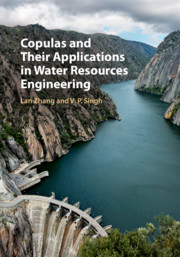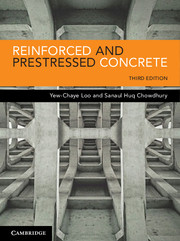Refine search
Actions for selected content:
2643 results in Civil and geotechnical engineering
8 - Entropic Copulas
- from Part One - Theory
-
- Book:
- Copulas and their Applications in Water Resources Engineering
- Published online:
- 03 January 2019
- Print publication:
- 10 January 2019, pp 304-328
-
- Chapter
- Export citation
13 - Drought Analysis
- from Part Two - Applications
-
- Book:
- Copulas and their Applications in Water Resources Engineering
- Published online:
- 03 January 2019
- Print publication:
- 10 January 2019, pp 489-536
-
- Chapter
- Export citation
2 - Preliminaries
- from Part One - Theory
-
- Book:
- Copulas and their Applications in Water Resources Engineering
- Published online:
- 03 January 2019
- Print publication:
- 10 January 2019, pp 20-61
-
- Chapter
- Export citation
Index
-
- Book:
- Copulas and their Applications in Water Resources Engineering
- Published online:
- 03 January 2019
- Print publication:
- 10 January 2019, pp 600-604
-
- Chapter
- Export citation
Part Two - Applications
-
- Book:
- Copulas and their Applications in Water Resources Engineering
- Published online:
- 03 January 2019
- Print publication:
- 10 January 2019, pp 365-599
-
- Chapter
- Export citation
17 - Interbasin Transfer
- from Part Two - Applications
-
- Book:
- Copulas and their Applications in Water Resources Engineering
- Published online:
- 03 January 2019
- Print publication:
- 10 January 2019, pp 586-599
-
- Chapter
- Export citation
6 - Plackett Copula
- from Part One - Theory
-
- Book:
- Copulas and their Applications in Water Resources Engineering
- Published online:
- 03 January 2019
- Print publication:
- 10 January 2019, pp 242-260
-
- Chapter
- Export citation
Contents
-
- Book:
- Copulas and their Applications in Water Resources Engineering
- Published online:
- 03 January 2019
- Print publication:
- 10 January 2019, pp vii-x
-
- Chapter
- Export citation
10 - Rainfall Frequency Analysis
- from Part Two - Applications
-
- Book:
- Copulas and their Applications in Water Resources Engineering
- Published online:
- 03 January 2019
- Print publication:
- 10 January 2019, pp 367-395
-
- Chapter
- Export citation
Dedication
-
- Book:
- Copulas and their Applications in Water Resources Engineering
- Published online:
- 03 January 2019
- Print publication:
- 10 January 2019, pp v-vi
-
- Chapter
- Export citation
Preface
-
- Book:
- Copulas and their Applications in Water Resources Engineering
- Published online:
- 03 January 2019
- Print publication:
- 10 January 2019, pp xi-xii
-
- Chapter
- Export citation

Copulas and their Applications in Water Resources Engineering
-
- Published online:
- 03 January 2019
- Print publication:
- 10 January 2019

Reinforced and Prestressed Concrete
-
- Published online:
- 12 December 2018
- Print publication:
- 26 July 2018
-
- Textbook
- Export citation
Acknowledgments
-
- Book:
- The Urban Ocean
- Published online:
- 10 October 2018
- Print publication:
- 01 November 2018, pp xiv-xiv
-
- Chapter
- Export citation
12 - Coastal Ocean Observing Systems
-
- Book:
- The Urban Ocean
- Published online:
- 10 October 2018
- Print publication:
- 01 November 2018, pp 167-183
-
- Chapter
- Export citation
9 - Coastal Processes and Shoreline Modification
-
- Book:
- The Urban Ocean
- Published online:
- 10 October 2018
- Print publication:
- 01 November 2018, pp 109-128
-
- Chapter
- Export citation
Preface
-
- Book:
- The Urban Ocean
- Published online:
- 10 October 2018
- Print publication:
- 01 November 2018, pp xi-xiii
-
- Chapter
- Export citation
8 - Urban Meteorology
-
- Book:
- The Urban Ocean
- Published online:
- 10 October 2018
- Print publication:
- 01 November 2018, pp 92-108
-
- Chapter
- Export citation
6 - Water Level Changes
-
- Book:
- The Urban Ocean
- Published online:
- 10 October 2018
- Print publication:
- 01 November 2018, pp 52-71
-
- Chapter
- Export citation
10 - Marine Pollution
-
- Book:
- The Urban Ocean
- Published online:
- 10 October 2018
- Print publication:
- 01 November 2018, pp 129-146
-
- Chapter
- Export citation
